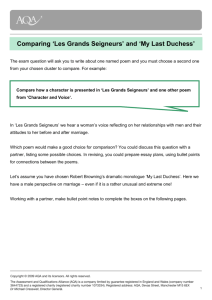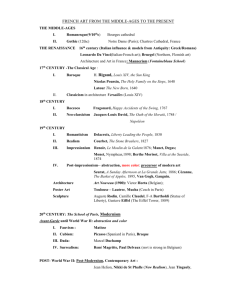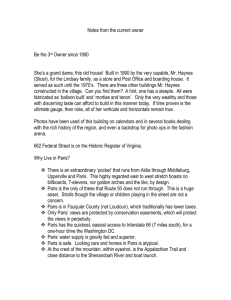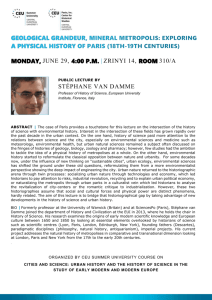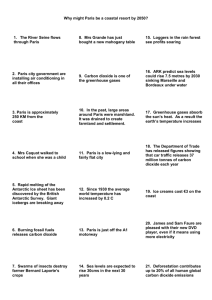Critical Analysis of the Flagship Urban Projects
advertisement
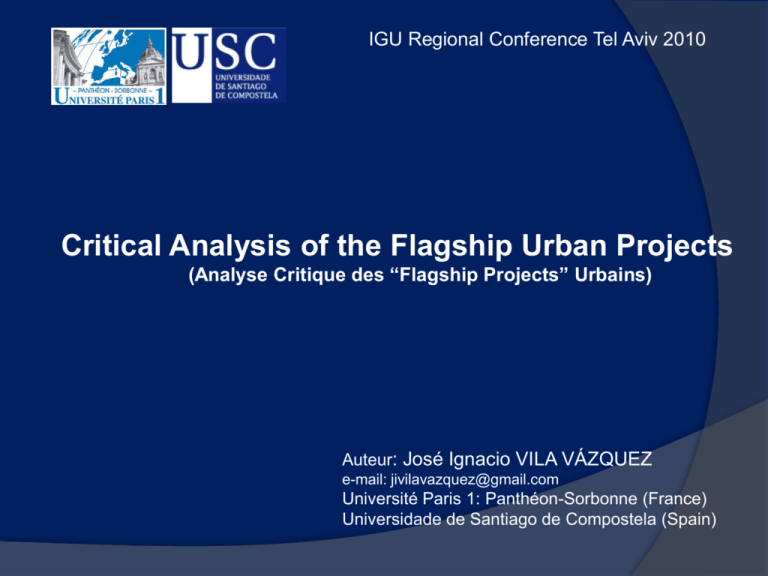
IGU Regional Conference Tel Aviv 2010 Critical Analysis of the Flagship Urban Projects (Analyse Critique des “Flagship Projects” Urbains) Auteur: José Ignacio VILA VÁZQUEZ e-mail: jivilavazquez@gmail.com Université Paris 1: Panthéon-Sorbonne (France) Universidade de Santiago de Compostela (Spain) INTRODUCTION GLOBAL OBJECTIVES (RESEARCH) 1-Evaluation of territorial impacts of the flagship urban projects (aspects: economic / social / image / physic) 2-Proposition of urban planning and strategic alternatives OBJECTIFS OF THIS PAPER -Assessment of territorial impacts in Paris: Critic analysis ―grands projets parisiens‖ after 1980: BNF F. Mitterrand -Presentation: other flagship urban projects (for further comparison and test of general hypothesis) PLAN OF THE PAPER: -Definition of the flagship urban projects, hypothesis and methodology for an critic analysis -‖Grands Projets‖ in Paris (1980 – 2008) -Case of the BNF F. Mitterrand -Other flagship projects: in Spain and in Portugal -Conclusions DEFINITION OF FLAGSHIP URBAN PROJECT -Piece or group of urban pieces (and their specific process of theoretical conception) -Symbolic of monumentality -Attractive image -Strategy of urban and territorial marketing -Symbol and catalytic role of a process of urban regeneration: Flagship projects are property developments in prestigious and significant sols. This projects play a catalytic role of a urban regeneration process and the transformation of the image of a city. -Different scales: from building to urban project -Different terms: ―Projets Phares‖ or ―Projets Emblématiques‖, « Grands Projets », « Grands Travaux », Mega Projects. Also: Iconic Buildings INITIAL HYPOTHESIS •The flagship urban projects produce a morphological and image transformation of the place. They promote processes of gentrification and urban regeneration. •The main objective indicated by politicians was the offer of a high level cultural service and public spaces of high quality. However, the origin of this projects competitiveness between cities who belong to a urban network of a same hierarchical level. The prime objective was the attraction or production of capital. •Their localisation was either in a symbolic central place of the city or in a socio-economic depressed central area with an unattractive image. •They constitute veritable landmarks and nodes of accumulation of tertiary and quaternary sector activities. These projects improve the accessibility of the environmental space of their sites. •The flagship projects have a high social cost because of a social substitution of the habitants of the neighbourhood. However they don’t constitute a veritable solution to social problems. They lead a population transfer to other areas. Their construction and maintenance costs are also large. METHODOLOGY (I) Comparability of selected flagship urban projects Aspects for critical analysis SCALE ASPECT Macro-scale (city and interurban) Meso-scale (Neighbourhood / zone) Micro-scale (Project and person) Morphology Physic transformation of a decline urban sector or a generation ex-novo of a urban zone Renovation, rehabilitation or construction ex-novo Design Image Contribution to global image of a city Image of a neighbourhood Perception of users Social Attract tourists and the transnational class Process of social transformation (substitution) Users of a place and social practices New installation of economic activities Cultural Activity of the master piece of the flagship urban project Attract capital Economic Competition between cities who belong to a same hierarchy level of a urban network TABLE: ASPECTS TO ANALYZE IN THIS RESEARCH IN FONCTION OF DIFFERENT SCALES AND APPROCHES METHODOLOGY (II) -Diachronic analysis of the physical transformation through cartography, photography and bibliographic references -Interviews to different users -Analysis of different spaces of representation and representation of spaces: documents like videos, photography, texts or touristic maps, and also graffitis, manifestations or singular events. -Exploratory data analyse of: .Tourists and quotidian users of the BNF .Population statistics and property characteristics of sols with residential function in the Tolbiac’s sector of the ZAC Rive Gauche -Participant observation in the flagship project and in their neighbourhood « GRANDS PROJETS » IN PARIS: 1980-2007 Années Les Grands Travaux où ils apparaissent cités (à partir de 1980) Institut du Monde Arabe 1981, 1987 Musée d’Orsay Grande Arche 1982 de la Défense Opéra Bastille 1983, 1989 1983, 1989 Grand Louvre et Pyramide 1983, 1989, 1990 Palais Omnisport de Bercy 1984 (Zénith, Grande Halle, Géode Cité des Sciences et de l’Industrie, Cité de et 1984, 1985, 1986, 1990 de la danse) Forum des Halles Eurodisneyland (Marne-laVallée) Pavillon de l’Arsenal Ministère des Finances à Bercy 1985 1985 1988 1989 Bibliothèque Nationale de France 1992, 1995 François Mitterrand Stade de France 1993, 1998 Cathédrale d’Evry 1995 Grands Travaux à Paris selon Fourcault,et al. (2007) « GRANDS PROJETS » IN PARIS: 1980-2007 These projects was considered from the speciality bibliography. They was able to have this characteristics: -Monumentality -Political power and capital concentration -Origin of tendencies of urban processes -‖Intra muros‖ Paris and ―banlieu‖ of proximity Selection of some of this projects: Villette, Opéra de la Bastille, Stade de France et BNF F. Mitterrand Common aspects: -Exaltation of the national identity -Design and star architecture -Emblematic building to generate an urban regeneration process -High economic costs -Interaction between project and place. Re-creation of the places -Main objective: stimulation of the consumption and offer a high quality service « BIBLIOTHÈQUE NATIONALE DE FRANCE » – F. MITTERRAND . ZAC RIVE GAUCHE *Recent evolution of the district of the ―Rive Gauche‖ *Analysis of the actors’ discourses, of the spaces of representation and representation of the space and morphological transformation. - Public initiative, concretely of the Republican President: F. Mitterrand - Urban Planning with a ―Zone d’Aménagement Concerté‖ ZAC. - Physic transformation of the place through a cover of train tracks. Mixed utilisation of the sol. Historical building remains (i.e. Les Frigos et les Grands Moulins). -Contradiction between the discourses of the actors: political, technical and public. *Social and economic transformation (statistical data) -Attraction of tourists (BNF) and transnational enterprises -Number of library’s users is stabilized (300 people/day ) -Cultural activities less important than economic activities -Neighbourhood with a low degree of vitality: contrast between day and night “BNF F. MITTERRAND”– (ZAC Rive Gauche). Paris Architect: D. Perrault (1991-1995) Photo. Three of four “open books” (Towers of the Bibliothèque François Mitterrand). Au premier plan de l’image nous pouvons voir les travaux du projet de la Rive Gauche dans le faisceau des voies ferrées.05/2008 23/02/2008 30/01/2010 30/01/2010 Publicity of the SEMAPA. Photo of the 06/04/2010 “BNF F. MITTERRAND”– (ZAC Rive Gauche). Paris Architect: D. Perrault (1991-1995) SECTEUR TOLBIAC. ZAC Rive Gauche. Paris Information Centre of the Rive Gauche (15/04/2008) Semapa (30/04/2008) TOLBIAC (T1-T3) CARACTÉRISITIQUES % Nbr % Total TYPE Surface Surf/Log Secteur Nbr Rive LOGEMENT Nbr (m2) (m2) Tolbiac Gauche Log. Sociaux 324 31303 96,6 38,9 23,8 Log. Libres 509 45683 89,8 61,1 37,4 Log. Étudiants 0 — — — 0,0 TOTAL (sauf étudiants) 833 76986 92,4 100,0 61,3 Background of the map: IGN 1981 Scaled model in the Informational Centre of the ―Rive Gauche‖ (15/04/2008) SOME FLAGSHIP PROJECTS IN THE IBERIAN PENINSULA: IMITATION PROCESS FROM PROJETS IN GLOBAL CITIES (London, Paris,...) & OTHER SUCCESSFUL CASES (Bilbao, Glasgow) CHOICE OF CASES (European Cities: small and medium size) -“Cidade da Cultura” (Santiago Compostela – Galicia, Spain) Large dimensions of the project Utilisation of the proposed services Dialog or opposition to historical centre? Localisation and accessibility -“Casa da Musica” (Porto - Portugal) Capacity of regeneration? – diminished (―degradado‖) area of Boavista European City of Culture: 2001 -“Ciutat de les Arts i de les Ciènces” (València – Spain) Politic strategy of urban and territorial image change Interaction with mega-events (F1, America’s Cup,...) Economic viability and sustainability (Para quien) For whose people? Photo of Paisajes Españoles (in Martí Arís, 1995) 04/07/2005 “Cidade da Cultura” depuis Mte. Pedroso “CIDADE DA CULTURA”. Santiago de Compostela (Galicia – Spain) 31/07/2006 “Cidade da Cultura” from the roof of the Faculty of Geography and History (Historique Centre) Architect: P. Eisenmann (1999-…) 18/06/2009 “Cidade da Cultura” “CASA DA MUSICA”. Porto (Portugal) Architect: R. Koolhaas (1999-2005) 21/03/2010 Casa da Musica (Porto) 13/10/2006 Casa da Musica (Porto) (Rio Fernandes, 2000) 21/03/2010 Casa da Musica (Porto) “CIUTAT DE LES ARTS I DE LES CIÈNCES”. València (Comunitat Valencià, Spain) Architect: S. Calatrava (1989-2005…) 28/04/2006 “Ciutat de les Arts i de les Ciènces” (València). Photos d’élaboration personnelle. 12/11/2007 València et la “Ciutat de les Arts i de les Ciènces” Source: google earth CONCLUSIONS FLAGSHIP URBAN PROJECTS (general) Urban marketing and inter-urban competitiveness GRANDS PROJETS PARIS Landmarks and a identification element for neighbourhood of Tolbiac and Paris Localisations: central and symbolic places and urban wastelands Main objective: attraction capital (tourist and enterprises of quaternary sector) Improvement of the urban image Improvement of the accessibility (i.e. metro 14) Node of accumulation and attraction of capital BNF F. MITTERRAND Landmark of the neighbourhood Physic Transformation of this area of Tolbiac Contradiction between the discourses of the different actors Functional and diurnal gentrification Neither fear nor vitality of this area PROJECTS IN SPAIN AND IN PORTUGAL Public strategy: symbols of modernisation Imitation: Grands Projets of F. Mitterrand and Bilbao’s Guggenheim Common characteristics: ―cultural‖ and controversial projects Necessity of a further analysis of economic and social transformations (meso and macroscales) to obtain a global assessment of the territorial impacts of the flagship projects BIBLIOGRAPHY (selection) Benjamin, W. 2003. Paris, capitale du XIXe siècle: exposé. Paris: Editions Allia. Bianchini, F., J. Dawson, y R. Evans. 1992. in ―Flagship projects in urban regeneration.‖ Rebuilding the City: Property Led Urban Regeneration. London: FN Spon. Bianchini, F., et Parkinson, M. 1994. Cultural policy and urban regeneration: the West European experience. Manchester Univ Pr. Debord, G. 1996. La Société du spectacle. Paris: Gallimard. Evans, G. 2005. ―Measure for measure: Evaluating the evidence of culture's contribution to regeneration.‖ Urban Studies 42:959-983. Evans, G. 2003. ―Hard-branding the cultural city – from Prado to Prada.‖ International Journal of Urban and Regional Research 27:417-440. Fainstein, S. S. 2008. ―Mega-projects in New York, London and Amsterdam.‖ International Journal of Urban and Regional Research 32:768-785. Harvey, D. 1997. ―Acumulación flexible, prácticas espaciais e clases sociais.‖ in As redes urbanas. Unha nova xeografía das cidades. Santiago de Compostela: Universidade de Santiago de Compostela. Harvey, D. 1989. ―From managerialism to entrepreneurialism: the transformation in urban governance in late capitalism.‖ Geografiska Annaler. Series B. Human Geography 71:3–17. Harvey, D. 2008. Géographie del la domination. Paris: Les Prairies Ordinaires. Lefebvre, H. 2000. La production de l'espace. 4º ed. Paris: Anthropos. Lynch, K. 1985. La imagen de la ciudad. 2º ed. México: Ed. G.Gili. Paddison, R. et Miles, S. 2009. Culture-led Urban Regeneration. London: Routledge. Paddison, R. 1993. ―City Marketing, Image Reconstruction and Urban Regeneration.‖ Urban Studies 30:339. Reason, M. et García, B. 2007. ―Approaches to the newspaper archive: content analysis and press coverage of Glasgow's Year of Culture.‖ Media Culture Society 29:304-331. Rosemberg, M. 2000. Le marketing urbain en question : production d'espace et de discours dans quatre projets de villes. Paris: Anthropos. Smyth, H. 1994. Marketing the city. London: Taylor & Francis. Zukin, S. 1998. ―Urban Lifestyles: Diversity and Standardisation in Spaces of Consumption.‖ Urban Studies 35:825-839.

